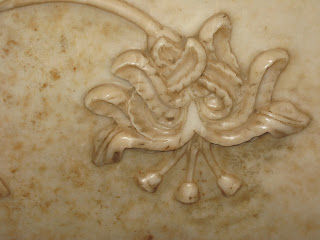Saturday, 30 July 2011
The Taj Mahal
The Taj Mahal is a mausoleum located in Agra, India. It was built by Mughal emperor Shah Alah Jahan in memory of his third wife, Mumtaz Mahal. The Taj Mahal is widely recognized as "the jewel of Muslim art in India and one of the universally admired masterpieces of the world's heritage." It is an "elegy in marble" or some say an expression of a "dream."
Taj Mahal (meaning Crown Palace) is a Mausoleum that houses the grave of queen Mumtaz Mahal at the lower chamber. The grave of Shah Jahan was added to it later. The queen’s real name was Arjumand Banu. In the tradition of the Mughals, important ladies of the royal family were given another name at their marriage or at some other significant event in their lives, and that new name was commonly used by the public. Shah Jahan's real name was Shahab-ud-din, and he was known as Prince Khurram before ascending to the throne in 1628.
Taj Mahal was constructed over a period of twenty-two years, employing twenty thousand workers. It was completed in 1648 C.E. at a cost of 32 Million Rupees. The construction documents show that its master architect was Ustad ‘Isa, the renowned Islamic architect of his time. The Taj stands on a raised, square platform (186 x 186 feet) with its four corners truncated, forming an unequal octagon. The architectural design uses the interlocking arabesque concept, in which each element stands on its own and perfectly integrates with the main structure. It uses the principles of self-replicating geometry and a symmetry of architectural elements.
Its central dome is fifty-eight feet in diameter and rises to a height of 213 feet. It is flanked by four subsidiary domed chambers. The four graceful, slender minarets are 162.5 feet each. The entire mausoleum (inside as well as outside) is decorated with inlaid design of flowers and calligraphy using precious gems such as agate and jasper. The main archways, chiseled with passages from the Holy Qur’an and the bold scroll work of flowery pattern, give a captivating charm to its beauty.
The mausoleum is a part of a vast complex comprising of a main gateway, an elaborate garden, a mosque (to the left), a guest house (to the right), and several other palatial buildings. The Taj is at the farthest end of this complex, with the river Jamuna behind it. The large garden contains four reflecting pools dividing it at the center. Each of these four sections is further subdivided into four sections and then each into yet another four sections.
Posted by Seven Wonders of the Ancient World at 03:30 0 comments
The Chichen Itza
Chichen Itza is a large pre-Columbian archaeological site built by the Maya civilization.The main attraction is the central pyramid, also known as El Castillo, this spectacular, massive Mesoamerican step-pyramid that dominates the Chichen Itza archaeological site in the Mexican state of Yucatan.
El Castillo served as a temple to the god Kukulkan and is believed to have served as a calendar. Each of the structures four stairways contains 91 steps. When counting the top platform as another step, in total El Castillo has 365 steps, one step for each day of the year. The structure is 24 meters tall (78 feet), plus an additional 6 m (20 feet) for the temple top for a total height of 30 meters (98 feet). The square base measures 55.3 meters (181 feet) across. Huge sculptures of plumed serpent’s heads sit at the base of the pyramid on the northern staircase.
Inside you will find a narrowly enclosed staircase that leads to a chac mool, an altar where offerings to the gods were placed. It is sometimes possible to visit the inside passageway of the pyramid. Climbing to the top of the pyramid is no longer allowed.
Posted by Seven Wonders of the Ancient World at 02:09 0 comments
Friday, 29 July 2011
The Machu Picchu
Machu Picchu is a pre-Columbian15th-century Inca site located 2,430 metres (7,970 ft) above sea level. It is situated on a mountain ridge above the Urubamba Valley in Peru, which is 80 kilometres (50 mi) northwest of Cusco and through which the Urubamba River flows.
Most archaeologists believe that Machu Picchu was built as an estate for the Inca emperor Pachacuti (1438–1472). Often referred to as the "Lost City of the Incas", it is perhaps the most familiar icon of the Inca World. Machu Picchu was built in the classical Inca style, with polished dry-stone walls. Its three primary buildings are the Intihuatana, theTemple of the Sun, and the Room of the Three Windows. These are located in what is known by archaeologists as the Sacred District of Machu Picchu.
Posted by Seven Wonders of the Ancient World at 08:23 0 comments
The Petra, Jordan
Petra is a historical and archaeological city in the Joedanian governorate of Ma'an that is famous for its rock cut architecture and water conduits system. Established sometime around the 6th century BC as the capital city of the Nabataeans, it is a symbol of Jordan as well as its most visited tourist attraction. It lies on the slope of Mount Hor in a basin among the mountains which form the eastern flank of Arabah (Wadi Araba), the large valley running from the Dead Sea to the Gulf of Aqaba. Petra has been a UNESCO World Heritage Site since 1985.
Inside the petra, jordan
Posted by Seven Wonders of the Ancient World at 07:40 0 comments
The Colosseum, Italy
The Colosseum, or the Coliseum, originally the Flavian Amphitheatre (Latin: Amphitheatrum Flavium, Italian Anfiteatro Flavio orColosseo), is an elliptical amphitheatre in the centre of the city of Rome, Italy, the largest ever built in the Roman Empire. It is considered one of the greatest works of Roman architecture and Roman engineering.
The elliptical building is immense, measuring 188m by 156m and reaching a height of more than 48 meter (159 ft). The Colosseum could accommodate some 55,000 spectators who could enter the building through no less than 80 entrances.
Above the ground are four storeys, the upper storey contained seating for lower classes and women. The lowest storey was preserved for prominent citizens. Below the ground were rooms with mechanical devices and cages containing wild animals. The cages could be hoisted, enabling the animals to appear in the middle of the arena.
Posted by Seven Wonders of the Ancient World at 06:57 0 comments
Wednesday, 27 July 2011
Photo about the Great Wall of China
Posted by Seven Wonders of the Ancient World at 08:57 0 comments
Subscribe to:
Comments (Atom)



















































